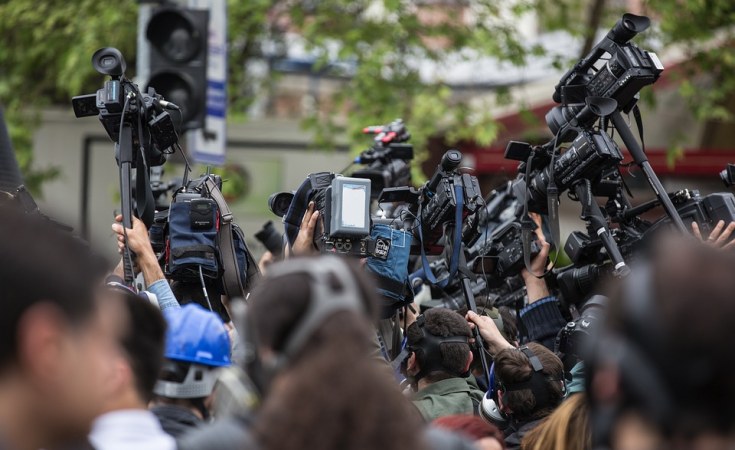Johannesburg, South Africa — As more people become concerned about the effects of climate change on their lives, journalists in an otherwise struggling industry are becoming specialized in the environmental beat.
But that wasn't always the case, said Frederick Mugira, founder of Water Journalists Africa, the largest network of journalists on the continent reporting on water.
Mugira said that when he started the organization in 2011, "not so much was being tackled about water." But now, "we have more journalists preferring to specialize in water and climate issues."
Mugira, an award-winning journalist based in Kampala, Uganda, founded the network to share ideas and provide training.
From investigative reporting on the impact of a large agricultural industry in Cameroon to how plastics and water pollution are devastating the fishing trade in the African Great Lakes, the coalition is combining environmental, data and solutions-led journalism.
Made up of about 1,000 journalists across Africa, the network works collaboratively to investigate issues around water, wildlife, biodiversity and climate change.
The nongovernmental organization receives funding from various institutions, including the U.S.-based Pulitzer Center and Internews, an international media support nonprofit organization in California.
The network also has a few specialized offshoots, including InfoNile, which uses graphics to map stories on the Nile Basin, and the Big Gorilla Project, which focuses on the endangered species in the forests of Congo, Rwanda and Uganda.
African nations are among the world's lowest greenhouse gas emitters, but scientists have long warned the region will be one of the worst affected by climate change. Mugira said that more than ever, local people want explanations of phenomena such as droughts.
"We identify a theme of common and cross-border importance. For example, plastic pollution," he said. "When we identify a theme, we search for credible data across the countries we're working on."
Water Journalists Africa projects include graphs and interactive maps and seek to break down data in a comprehensible and colorful way. Radio, TV and print are some of the mediums used, and the stories are published in English and local languages.
"When we started it, we realized journalists in the region didn't have experience in data journalism," Mugira said. But accessing that data can be a challenge.
One reason, Mugira said, is that scientists don't always trust journalists and don't always want to share their information. Another challenge comes when some government officials might want to release only numbers that show them in a good light.
"When it comes to natural resources, they don't really release data, because they see it as sensitive," he added.
Reporting with results
For Nairobi journalist Sharon Atieno, 29, being a member of Water Journalists Africa opened her up to a wide range of new skills.
"The network has helped shape my environmental reporting, and I've also learned to use data," said Atieno, who learned of the network when applying for grants.
"You can use maps, visualizations, to make it more captivating. This is a skill I acquired not through university but through being part of the Water Journalists Network. That's how I discovered my beat," she said.
Asked why she thought the beat was important, Atieno said, "Everything around us is the environment -- plastics in the oceans, polluted lakes, everything has an impact not only on the environment but also on climate change.
"Environment reporting is important because even tiny things we're doing, if you look at it accumulatively, it's having a very big impact on our lives as human beings."
Atieno said everything is connected. For example, more drought results in increased wildlife poaching as people's crops fail and they go hungry.
Atieno has taken part in collaborations with Water Journalists Africa. One story she was particularly proud of looked at how poaching for bushmeat increased when Kenya was under the pandemic lockdown. The poaching resulted in a decline in the population of the country's iconic Rothschild's giraffe, she said.
Another story she covered was how waste from sugarcane companies in a part of western Kenya was polluting a nearby river.
"The degradation of the sugarcane waste results in a chemical being produced so when it goes into the water system, it makes the rivers toxic," she said. "When I did that story, I reached out to the county government. They said they didn't know it was happening."
After she covered the story, the county authorities opened a commission to investigate the issue.
Funding challenges
Cross-border networks of environmental journalists in Africa are growing, according to Anton Harber, adjunct professor of journalism at Witwatersrand University in Johannesburg.
"At our annual gathering of the continent's investigative journalists, the African Investigative Journalism Conference, we have definitely seen environmental coverage take center stage with the emergence of a number of cross-border, collaborative networks doing important and often excellent work," he told VOA.
However, he said, such work needs funding to be able to survive.
"Few newsrooms are investing in it because it is not seen as a topic that sells newspapers or brings clicks," Harber said. "Africa has the stories and the journalists who can tackle it, but they are not usually in the mainstream conventional newsrooms."
But Mugira said stories from his network were now being picked up and followed by other media as interest in their coverage grows.
"These stories are just a starting point," he said.


